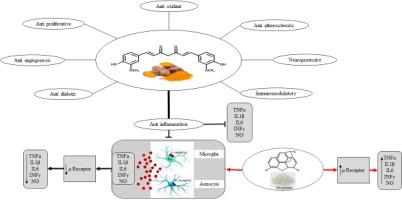Neuropeptides ( IF 2.9 ) Pub Date : 2022-12-29 , DOI: 10.1016/j.npep.2022.102318 Mohammad Abbas Sheikholeslami 1 , Siavash Parvardeh 1 , Shiva Ghafghazi 1 , Masoumeh Sabetkasaei 1

|
In recent years, the association between neuroinflammation and opioid dependence has attracted considerable attention. Curcumin, a component of the Curcuma longa, has been shown to act as a suppressor of glial cells and inflammatory cytokines. The main goal of this study was to explore the attenuating effects of curcumin on morphine dependence with a focus on neuroinflammation and μ-opioid receptors in the rat prefrontal cortex. To induce morphine dependence in male Wistar rats, morphine was administered i.p. once daily for 18 days in an escalating dose of 10, 20, and 40 mg/kg. Curcumin (2.5, 5, and 10 mg/kg, i.p.) was given from the days 10th to 18th. Immunofluorescence staining and ELISA methods were used to evaluate glial cells activity and inflammatory cytokines levels, respectively. Western blotting was used to evaluate the expression of μ-opioid receptors. The administration of curcumin (2.5, 5, and 10 mg/kg) for 9 days significantly attenuated the symptoms of morphine withdrawal syndrome. The prefrontal cortex concentration of TNF-α and IL-6 was also reduced by curcumin (2.5, 5, and 10 mg/kg) significantly. Furthermore, curcumin decreased the number of Iba1 and GFAP positive cells in morphine-dependent rats. Moreover, the expression of μ-opioid receptors was significantly reduced by curcumin (10 mg/kg). The results of this study demonstrate that curcumin attenuates morphine dependence in rats through an inhibitory effect on neuroinflammation and a decrease in the expression of μ-opioid receptors in the prefrontal cortex.
中文翻译:

姜黄素通过调节大鼠的 μ-阿片受体和神经胶质细胞激活的神经炎症减轻吗啡依赖
近年来,神经炎症与阿片类药物依赖之间的关联引起了相当大的关注。姜黄素,姜黄的一种成分, 已被证明可作为神经胶质细胞和炎性细胞因子的抑制剂。本研究的主要目标是探讨姜黄素对吗啡依赖的减弱作用,重点关注大鼠前额皮质中的神经炎症和μ-阿片受体。为了在雄性 Wistar 大鼠中诱导吗啡依赖性,以 10、20 和 40 mg/kg 的递增剂量每天腹腔注射吗啡一次,持续 18 天。从第 10 天到第 18 天给予姜黄素(2.5、5 和 10 mg/kg,ip)。免疫荧光染色和 ELISA 方法分别用于评估神经胶质细胞活性和炎性细胞因子水平。蛋白质印迹用于评估μ-阿片受体的表达。给予姜黄素(2.5、5 和 10 mg/kg)9 天可显着减轻吗啡戒断综合征的症状。姜黄素(2.5、5 和 10 mg/kg)也显着降低了 TNF-α 和 IL-6 的前额皮质浓度。此外,姜黄素减少吗啡依赖大鼠中 Iba1 和 GFAP 阳性细胞的数量。此外,μ-阿片受体的表达被姜黄素 (10 mg/kg) 显着降低。这项研究的结果表明,姜黄素通过对神经炎症的抑制作用和前额皮质中 μ-阿片受体表达的减少来减轻大鼠的吗啡依赖。



























 京公网安备 11010802027423号
京公网安备 11010802027423号